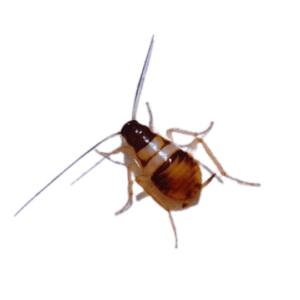
Brown-Banded Cockroach

Resilient Traits, Size, and Adaptability of Brown-Banded Cockroaches
Brown-Banded Cockroach (Supella longipalpa) are common household pests that demand attention. They exhibit a strong preference for warm and dry environments. These resilient pests can be found in various locations within homes, preferring high-up areas such as ceilings and upper cabinets. Their adaptability to drier conditions sets them apart from other cockroach species.
Brown-banded cockroaches are characterized by a small size, typically around 1/2 to 5/8 inches in length. Their bodies feature distinctive light bands across their wings and abdomen, setting them apart from other cockroach species. This unique anatomy aids in their identification
These omnivores consume a wide range of food sources, including starches, adhesives, and even household items. Their adaptability in finding sustenance contributes to their resilience in various environments.
Health Hazards and Household Threats
Brown-banded cockroaches, like other cockroach species, pose a health risk by carrying pathogens and bacteria on their bodies and in their feces, potentially spreading diseases to surfaces and food preparation areas as they move around homes and other environments.
Their presence contributes to indoor air quality problems and allergic reactions, particularly in sensitive individuals, as they produce allergens through shed skin, saliva, and feces.
These cockroaches exhibit destructive feeding habits, chewing on materials such as paper, cardboard, and fabrics, leading to damage to books, clothing, and various household items.
Brown-banded cockroaches have been around for an extended period, with their existence spanning several decades. Their successful adaptation to various environmental conditions and the ability to thrive in human habitats contribute to their age-old legacy as persistent household pests.
Lifecycle: The Reproductive Journey
Brown-banded cockroaches are prolific breeders. Females produce egg cases, or oothecae, which contain multiple eggs. This reproductive strategy, coupled with rapid maturation, allows these pests to swiftly expand their populations, creating challenges for homeowners.
The life cycle of Brown-banded cockroaches comprises three stages: egg, nymph, and adult. After the eggs hatch, nymphs undergo molting stages before maturing into reproductive adults. This cyclical process ensures the continuation of their presence and ongoing challenges for pest control.
Conclusion
In conclusion, understanding the habits, habitats, and contributions of Brown-banded cockroaches is crucial for effective pest management. While they present challenges to homeowners, appreciating their adaptability and historical significance allows for informed strategies in maintaining a pest-free living environment.

